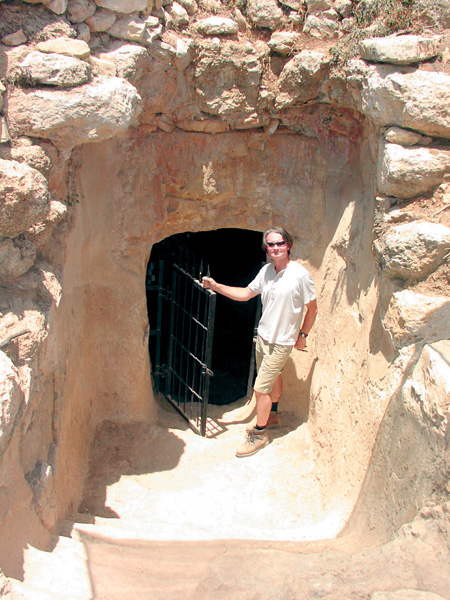
We found the cave by chance in the winter of 1999 when I (Shimon Gibson) was conducting an archaeological survey of ancient agricultural remains on the slopes of the hills and in the wadis next to Kibbutz Tzova, a short distance from the traditional hometown of John the Baptist at Ain Karim, west of Jerusalem. Crawling into the cave, whose entrance was hidden by a thicket of bracken and thorn bushes, I was completely surprised to see on the wall the crude visage of a man holding a staff with one arm raised as if in proclamation, as well as other symbols, such as an arm and a head, and Christian crosses. It was an exciting discovery and, given that I was in an area richly associated with John the Baptist, it immediately occurred to me that these drawings might have something to do with his memory or veneration. Indeed, I thought at the time that the central figure might well be an attempt to depict John the Baptist himself.
Among those I spoke with about what I had found was James Tabor, of the University of North Carolina at Charlotte. He expressed an interest in joining me in a thorough excavation of the site and the two of us became co-directors of the excavation of the Cave of Suba (after the old name of the site).1
The long, narrow rock-cut hall extended 78 feet into the heart of a mountain, with a width of about 13 feet. Large boulders were heaped up on both sides of the cave’s interior, and thick layers of soil reached almost to the ceiling.
It soon became obvious that the cave was not simply an abandoned reservoir haphazardly filled with mud, silt, rocks and washed-in debris. We were clearly into carefully stratified archaeological layers that were unambiguously dated by discrete layers of pottery.
We began scrutinizing the layers closely, and we utilized the latest scientific procedures to test the material as it emerged from the ground: flotation and micro-artifact analysis, geomorphological examination of silts between floors, quantification and seriation procedures on the masses of pottery uncovered, and tests on the plaster, both radiometric as well as thorium-uranium dating. We worked extremely slowly since we did not want to miss even one shred of evidence. The amount of ceramic material we extracted from the ground was overwhelming, and its full and final publication should be very significant for understanding the chronological sequence of pottery types within the early Roman period.
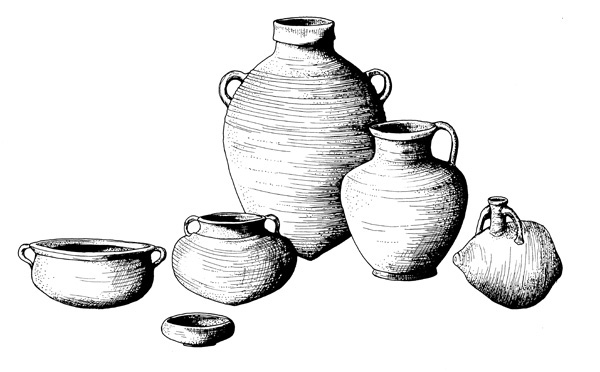
Approximately 6 feet of material provided a sequence extending from the late first century B.C. to the mid-second century A.D. These early Roman layers contained enormous quantities of shattered ceramic vessels. A very large proportion of these turned out to be one-handled jugs, not the type of vessel one would expect to find within water cisterns (storage jars would be much more sensible). We did not find any whole vessels, only potsherds; the pulverized potsherds lay on the floor surfaces. This indicates that the jugs had been intentionally smashed. Even more striking was that the ceramic evidence showed this practice was going on for at least 150 years—beginning in the first century A.D.—the time of John the Baptist. None of us could explain this, nor had anyone we talked to ever encountered anything like this elsewhere. The silt accumulating within the cave during the winter months from the annual rains was never removed, the walls were never replastered and hard-tamped earthen floors were created descending towards the back of the cave where the rainwater accumulated as in a pond. Cultic stone basins were incorporated within the floors to the right as one entered the cave, a series of stone circles (some paved) were built on top of the floors, and in the lower floors a “pathway” bordered by a row of stones on either side led down towards the back of the cave.
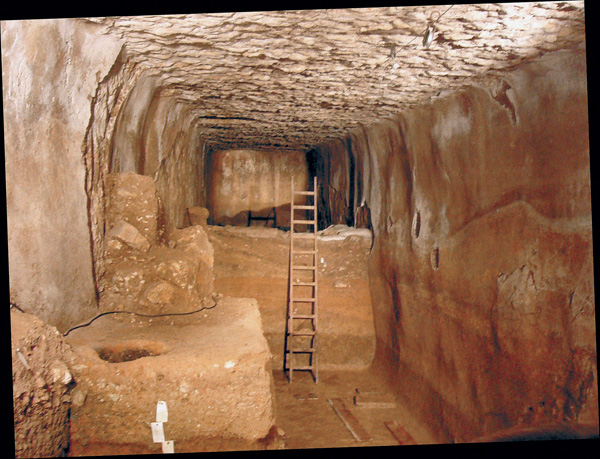
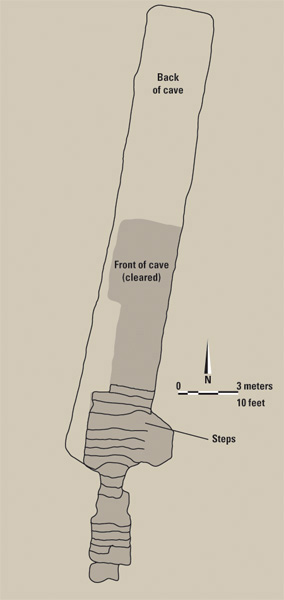
An important piece of the puzzle turned up when we uncovered a very large and unusual stone close to one of the earliest earthen floors in the cave. The upper surface of this stone was carved with the sunken shape of a right foot and leading to it was a channel extending from a small round depression that would have held a jug. Clearly the stone was used for the anointing of right feet with some kind of liquid, perhaps oil. The anointing of feet with oil is referred to in the Gospels, not in connection with John but with Jesus, whose feet were anointed with perfumed oil by Mary Magdalene (John 12:13). The fact that only the right feet were anointed on our stone must indicate it was part of some cultic ritual; otherwise there should also have been a stone with an imprint of the left foot, but none was found. The discovery of this foot-anointing stone, combined with the evidence that the cave was not used for any kind of domestic or agricultural activity, suggested that the cave was being used in this period for various kinds of ritual activities, including water purification rites.
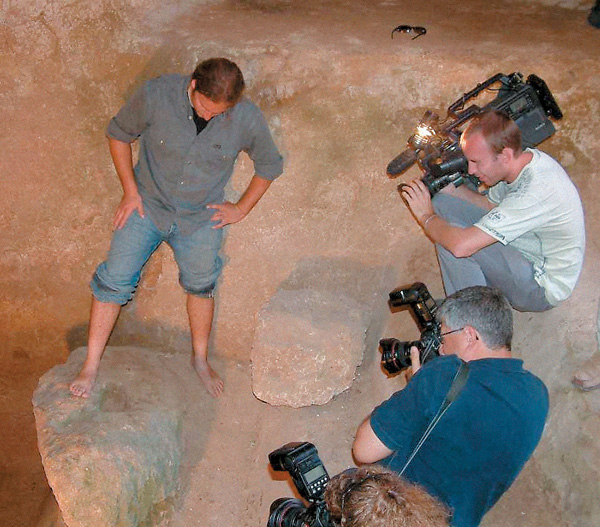
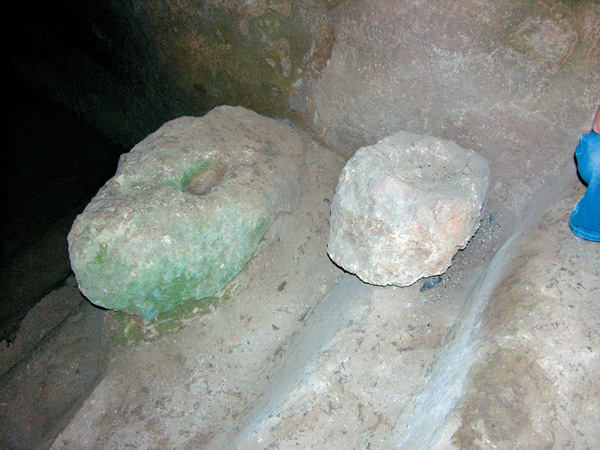
Because of the size of the cave and the unusual character of its installations, we believe it was used for group rituals that were performed in the front part of the cave before and after what was most likely some type of immersion procedure. As best we can put things together, people would have gathered in the front of the cave and then some kind of ceremony was performed, with individuals standing within the stone circles and using ceramic jugs, perhaps to pour water upon each other before ceremonially smashing the jugs. Subsequently, those who were gathered there immersed themselves within the water found near the back of the cave. On emerging, their right feet were anointed.
The ritual immersion procedures that took place in our cave in the early Roman period seem to resemble the baptism ceremonies performed by John the Baptist at the Jordan River (Mark 1:9–11). According to the Gospel accounts, crowds gathered to listen to John’s teachings, accompanied perhaps with fasting (Mark 2:3) and set prayers (Luke 11:1). This led to the remission of sins, perhaps with water being ritually sprinkled over the people. This took place on the bank of the Jordan River before the immersion itself. Having undergone purification of the spirit, so to speak, people then descended into the river in order to purify the flesh, with John calling on the divine name and perhaps pouring libations. Emerging from the water there must have been an expectation that the holy spirit (the shekhinah) would ultimately descend upon those who had been purified.
The two main stages of this baptism ceremony, with activities relating to the remission of sins on the bank of the river and activities relating to the purification of the flesh during the actual immersion in the river, would seem to be mirrored in the archaeological remains we uncovered from the early Roman period in the cave at Suba. In the front of the cave are earthen embankments, with installations and ceremonial features, where people would have gathered; at the back of the cave was water in which people would have immersed themselves.
Our first hint that the cave may have had an earlier history came from a geologist and expert in ancient plaster, Aryeh Shimron. While visiting the cave, he proclaimed that, based on the consistency of the plaster, it must be from the Iron Age. At the time none of us had even considered such a possibility. Now it is clear that probably from the ninth to eighth centuries B.C. the cave was part of a type of sophisticated water system that will be described for BAR readers in a future article by Tsvika Tsuk, a leading expert on ancient water systems.
There is a problem here, however, that is difficult to answer: What would a water system of such technological sophistication be doing so far away from any Iron Age city or village? The closest settlement from the Iron Age is in fact at Suba, but the distance involved and the fact that there was already an abundance of springs and water systems there would seem to make unecessary an additional water system such as ours. Since there was no settlement surrounding our cave, nor was it situated next to any major road, it is difficult to determine what it was used for. It was not used for irrigation purposes since there is no evidence of water-lifting devices at the cave. It is also unlikely to have been used for watering animals since they could not have managed to descend the steep 18 steps into the cave without breaking their legs.
If the purpose of the cave was simply to provide drinking water for the occasional passerby, then a much smaller cistern would have sufficed. One possibility is that it served as a major source for drinking water for the Judahite state administrators—but only at times of crisis. Such a reservoir with a water-collecting system along a valley may even have been referred to in the Old Testament as gbym (singular gbi), which have been translated in the past as “ditches” or “pools.” 2 Kings 3:16–17 makes it clear that the gbym were features situated in valley landscapes and that they were sources of water that were tapped when water was scarce. Such installations would have made excellent pools for bathing at times when water was plentiful.
Our cave also had a later history, after the time of John the Baptist. When the cave was apparently abandoned after the early Roman period, it continued to build up silt so that in the Byzantine period someone standing in the cave could almost reach the ceiling. And this brings us to the startling drawings chiseled into the old Iron Age plaster on the walls.
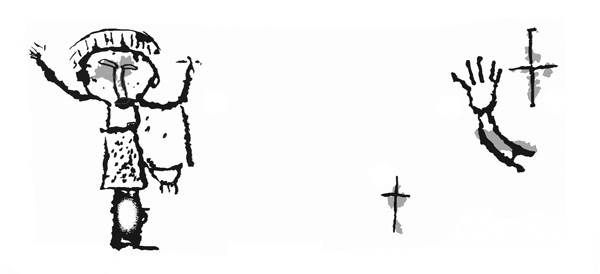
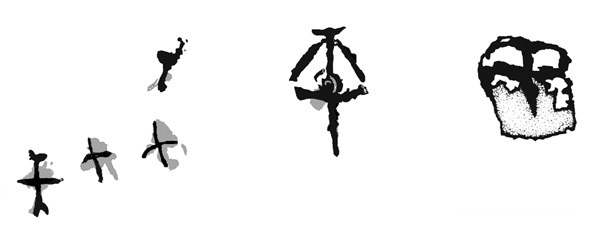
The drawings are quite large (the man is about 2.5 feet high). Due to the hard cement-like consistency of the plaster, the person who originally made the drawings must have used a chisel (which is also indicated by the breaks and fractures of the lines).
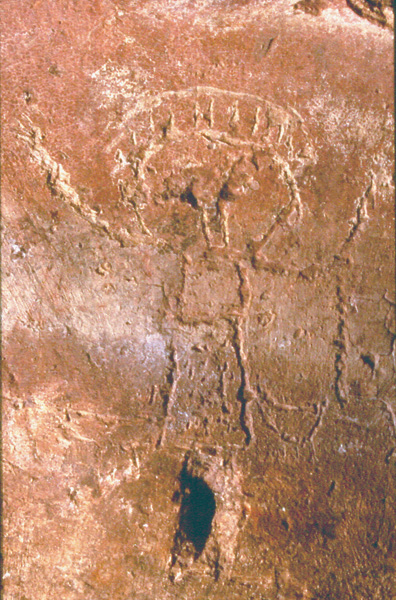
The main drawing is of a shepherd-like figure shown with upraised arms, a large head with eyes gouged out (probably by some iconoclast) and with a crooked staff resting against his left hand. The figure wears a hairy garment (indicated by a series of 32 dots), which reminds us that John the Baptist is said to have worn an “outer garment of camel’s hair and a leather girdle” (Mark 1:6). Next to him on his left is a schematic representation of a vessel on a tripod, or a lamb. If indeed this is a representation of a lamb it may be linked to John 1:36, in which the Baptist proclaims Jesus the “lamb of God.” Below the drawing of the figure is an oval hole, which likely contained some relic (perhaps a finger bone or a piece of cloth), with marks along the edges indicating that wire netting was hammered over it to keep the relic in place.
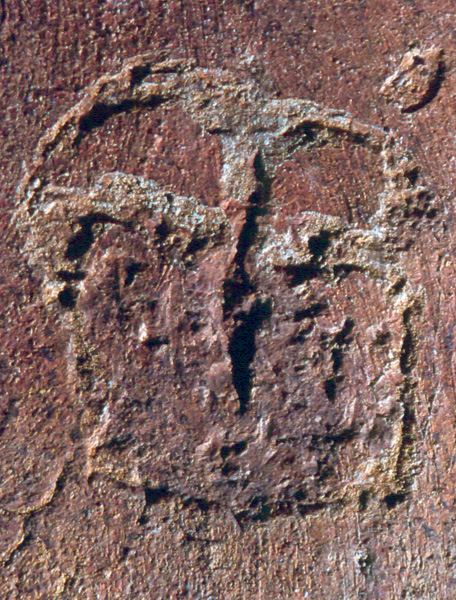
Other drawings also appear to be connected to the Byzantine tradition of John the Baptist. Cut into the wall opposite the main figure is a drawing of a head; this probably symbolizes the decapitation of the Baptist at Machaerus, or his relic head. According to the Gospels, Herodias and Salome demanded from Herod Antipas the head of John on a platter. There are numerous relic heads said to be that of John in churches around the Mediterranean and the Near East. On a nearby wall is a life-size drawing of an upraised arm that is probably a rendition of the relic arm of the Baptist. Early church sources relate how at the time of Julian the Apostate (c. 363 A.D.), the tomb of John the Baptist at Sebaste (Samaria) was broken into and desecrated by pagans and his bones scattered. However, certain visiting pilgrims from the Monastery of St. Philip in Jerusalem saved his relic arm or hand from destruction. A superb gilded relic arm of John the Baptist is kept in the Topkapi Palace in Istanbul in Turkey. The drawing in our cave may be of this relic arm.
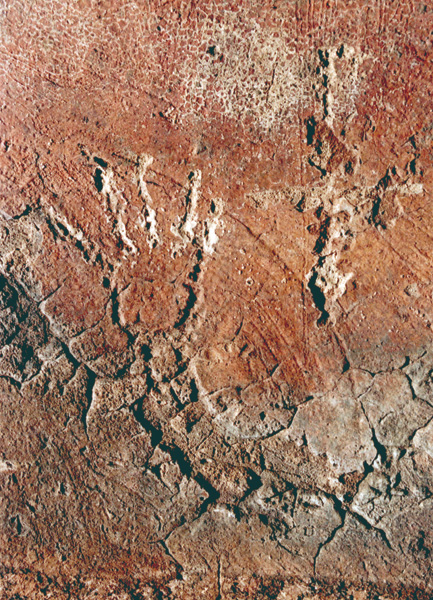
Other drawings on the walls of the cave include a T-shaped staff with streamers on the sides, “Greek”-type crosses and a group of three crosses that most likely symbolize the crucifixion of Jesus and the two thieves on Golgotha.

The iconography of the drawings indicates a Byzantine to early Islamic date. The drawings must have been incised into the walls sometime between the fourth and eleventh centuries.
The drawings are not random graffiti but were clearly undertaken at one time by one individual. They represent a coherent set of features intended as a means of redirecting the observer towards a clarification of faith. Otherwise they would be meaningless. In a sense they served as visual aids, as triggers or cues during a storytelling instruction given to monks, describing John the Baptist (represented by the drawing of his figure and possibly by a relic), his first martyrdom (the beheading shown by a drawn head), his second martyrdom (represented by the drawing of John’s arm retrieved following the desecration of his tomb), his function as the precursor of Christ (shown here by the symbol of his staff), the coming of Jesus (shown by a large cross) and the Crucifixion (shown by the three crosses on Golgotha).a
Most probably this was a memorial cave used by monks coming from the nearby Monastery of Zacharias and Elizabeth (named after John’s parents), about an hour’s walk away at Ain Karim (ancient Beth Haccerem) which was the traditional hometown of John the Baptist mentioned as a “city of Judah” in Luke 1:39–40. Today this monastery is known as the Church of the Nativity of St John. Archaeological remains uncovered beneath the church includes a first-century A.D. dwelling with a miqweh, a Jewish ritual bath.
Because the Suba cave evidently had no domestic function and was not in continuous use during this 700-year period (from the fourth to eleventh century A.D.), we assume monks came to the cave for instruction about John the Baptist and to recall his solitude in the wildernesses (Luke 1:80), and perhaps also to mark John’s nativity or death according to dates in the Eastern Byzantine calendar.
Why did the Byzantine monks choose this specific cave as a memorial cave? We shall probably never know for sure, but it is likely that this was because of some oral tradition connected to the cave going back to Roman times, which seems to be confirmed by our archaeological evidence that unusual baptism practices were performed at the cave precisely at the time of John the Baptist.
Uncredited photos courtesy of the Jerusalem Archaeology Field unit.
MLA Citation
Endnotes
Excavations were conducted at the cave from 2000 to 2003 by Shimon Gibson and James Tabor on behalf of the University of North Carolina at Charlotte and the Jerusalem Archaeology Field Unit, and with the sponsorship of the Jerusalem Historical Society (directed by the late Joseph Peeples) and the Foundation for Biblical Archaeology (directed by Sheila Bishop). The project was funded through the generosity of the John C. Whitehead and the Altman-Kaziekes Foundations. Principal team members consisted of Egon Lass (field director and flotation expert), Rafi Lewis (site manager and assistant field director), Reuven Kalifon (kibbutz liaison), Noël Siver (pottery restoration), Fadi Amirah (surveyor) and Sandu Mendrea (photography). Specialists working with us included Neil Munro (geomorphology), Edward Maher (archaeozoology), Aryeh Shimron (plaster expert), Mira Matthews (thorium-uranium tests) and Elisabetta Boaretto (radiocarbon tests). Our thanks are extended to the members of Kibbutz Tzova for the logistical support they lent to the expedition throughout the dig. Recent conservation work was conducted at the cave by the conservation department of the Israel Antiquities Authority. To visit the cave contact Yael Kerem at Kibbutz Tzova: shivuk@tzuba.org.il or the archaeological team at johnthebaptistcave@yahoo.com.

